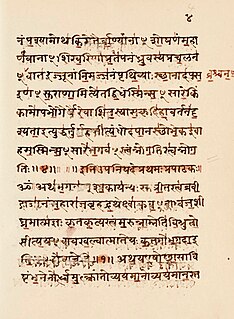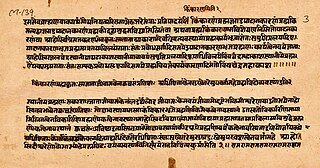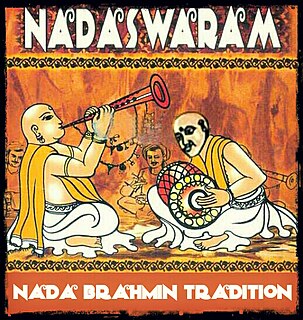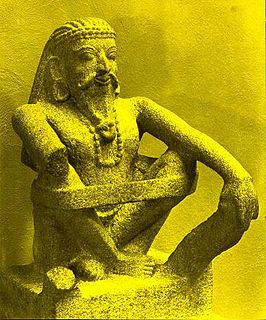Related Research Articles

The Upanishads are late Vedic Sanskrit texts of religious teachings which form the foundations of Hinduism. They are the most recent part of the oldest scriptures of Hinduism, the Vedas, that deal with meditation, philosophy, and ontological knowledge; other parts of the Vedas deal with mantras, benedictions, rituals, ceremonies, and sacrifices. Among the most important literature in the history of Indian religions and culture, the Upanishads played an important role in the development of spiritual ideas in ancient India, marking a transition from Vedic ritualism to new ideas and institutions. Of all Vedic literature, the Upanishads alone are widely known, and their central ideas are at the spiritual core of Hinduism.
Ātman is a Sanskrit word that means inner self, spirit, or soul. In Hindu philosophy, especially in the Vedanta school of Hinduism, Ātman is the first principle: the true self of an individual beyond identification with phenomena, the essence of an individual. In order to attain Moksha (liberation), a human being must acquire self-knowledge. For the different schools of thought, self-realization is that one's true self (Jīvātman) and the ultimate reality (Brahman) are: completely identical, completely different, or simultaneously non-different and different.

Moksha, also called vimoksha, vimukti and mukti, is a term in Hinduism, Buddhism, Jainism and Sikhism for various forms of emancipation, enlightenment, liberation, and release. In its soteriological and eschatological senses, it refers to freedom from saṃsāra, the cycle of death and rebirth. In its epistemological and psychological senses, moksha is freedom from ignorance: self-realization, self-actualization and self-knowledge. Moksha in its most basic definition is the freedom from rebirths.

Adi Shankaracharya was an Indian philosopher and theologian who consolidated the doctrine of Advaita Vedanta. Although he is credited by some with unifying and establishing the main currents of thought in Hinduism, his influence on Hindu intellectual thought has been questioned; until Vācaspati Miśra, his works may have been overshadowed by his older contemporary, Maṇḍana Miśra. The historical fame and cultural influence of Shankara may have grown centuries later after his death, particularly during the era of Muslim invasions and consequent devastation of India.

Advaita Vedānta is a school of Hindu philosophy, and is a classic system of spiritual realization in Indian tradition. The term Advaita refers to the idea that Brahman alone is ultimately real, the phenomenal transient world is an illusory appearance (maya) of Brahman, and the true self, atman, is not different from Brahman.

The Maitrayaniya Upanishad is an ancient Sanskrit text that is embedded inside the Yajurveda. It is also known as the Maitri Upanishad, and is listed as number 24 in the Muktika canon of 108 Upanishads.

The Yajurveda is the Veda primarily of prose mantras for worship rituals. An ancient Vedic Sanskrit text, it is a compilation of ritual-offering formulas that were said by a priest while an individual performed ritual actions such as those before the yajna fire. Yajurveda is one of the four Vedas, and one of the scriptures of Hinduism. The exact century of Yajurveda's composition is unknown, and estimated by Witzel to be between 1200 to 800 BCE, contemporaneous with Samaveda and Atharvaveda.
Paramatman or Paramātmā is the Absolute Atman, or supreme Self, in various philosophies such as the Vedanta and Yoga schools in Hindu theology, as well as other Indian religions like Sikhism. Paramatman is the "Primordial Self" or the "Self Beyond" who is spiritually identical with the absolute and ultimate reality. Selflessness is the attribute of Paramatman, where all personality/individuality vanishes.

The Isha Upanishad is one of the shortest Upanishads, embedded as the final chapter (adhyāya) of the Shukla Yajurveda. It is a Mukhya Upanishad, and is known in two recensions, called Kanva (VSK) and Madhyandina (VSM). The Upanishad is a brief poem, consisting of 17 or 18 verses, depending on the recension.

The Māṇḍūkya Upaniṣad is the shortest of all the Upanishads, and is assigned to Atharvaveda. It is listed as number 6 in the Muktikā canon of 108 Upanishads.
The oral tradition of the Vedas (Śruti) consists of several pathas, "recitations" or ways of chanting the Vedic mantras. Such traditions of Vedic chant are often considered the oldest unbroken oral tradition in existence, the fixation of the Vedic texts (samhitas) as preserved dating to roughly the time of Homer.

The Shvetashvatara Upanishad is an ancient Sanskrit text embedded in the Yajurveda. It is listed as number 14 in the Muktika canon of 108 Upanishads. The Upanishad contains 113 mantras or verses in six chapters.

The Katha Upanishad is one of the mukhya (primary) Upanishads, embedded in the last short eight sections of the Kaṭha school of the Krishna Yajurveda. It is also known as Kāṭhaka Upanishad, and is listed as number 3 in the Muktika canon of 108 Upanishads.
The Agamas are a collection of several Tantric literature and scriptures of Hindu schools. The term literally means tradition or "that which has come down", and the Agama texts describe cosmology, epistemology, philosophical doctrines, precepts on meditation and practices, four kinds of yoga, mantras, temple construction, deity worship and ways to attain sixfold desires. These canonical texts are in Sanskrit, Telugu and Tamil.

Brahman connotes the highest Universal Principle, the Ultimate Reality in the universe. In major schools of Hindu philosophy, it is the material, efficient, formal and final cause of all that exists. It is the pervasive, infinite, eternal truth and bliss which does not change, yet is the cause of all changes. Brahman as a metaphysical concept refers to the single binding unity behind diversity in all that exists in the universe.

Hindu scriptures are classified into two parts: shruti or śruti, meaning what has been heard and smriti, or smṛti, meaning what has been retained or remembered. The Vedas are classified under śruti.

Shabda Brahman or Sabda-brahman or Nada brahman means transcendental sound or sound vibration or the transcendental sound of the Vedas or of Vedic scriptures.

The Tejobindu Upanishad is a minor Upanishad in the corpus of Upanishadic texts of Hinduism. It is one of the five Bindu Upanishads, all attached to the Atharvaveda, and one of twenty Yoga Upanishads in the four Vedas.

The Brahmavidya Upanishad is a Sanskrit text and one of the minor Upanishads of Hinduism. It is one of twenty Yoga Upanishads in the four Vedas.

The Mantrika Upanishad is a minor Upanishad of Hinduism. The Sanskrit text is one of the 22 Samanya Upanishads, is part of the Vedanta and Yoga schools of Hindu philosophy literature, and is one of 19 Upanishads attached to the Shukla Yajurveda. In the Muktika canon, narrated by Rama to Hanuman, it is listed at number 32 in the anthology of 108 Upanishads.
References
- ↑ Kathaka Samhita.
- ↑ Vedic Index of Names and Subjects Vol.1. A1 Books Co. 1995. p. 281. ISBN 9788120813328.
- ↑ Shubhra Sharma (1985). Life in the Upanishads. Abhinav Publications. p. 209. ISBN 9788170172024.
- ↑ R.D.Ranade (1926). A Constructive Survey of Upanishadic Philosophy. Bharatiya Vidya Bhavan. p. 23.
- ↑ Benimadhab Barua (1970). A History of Pre-Buddhistic Indian Philosophy. A1 Books Co. p. 206. ISBN 9788120807969.
- ↑ Shrinivas Tilak (July 1989). Religion and Aging in Indian Tradition. Suny Press. p. 83. ISBN 9780791400456.
- ↑ Surendranath Dasgupta (1985). Yoga Philosophy: In Relation to Other Systems of Indian Thought. Motilal Banarsidass. p. 48. ISBN 9788170172024.
- ↑ Gavin D. Flood (1996). An Introduction to Hinduism . Cambridge University Press. p. 95.
Sakayanya.